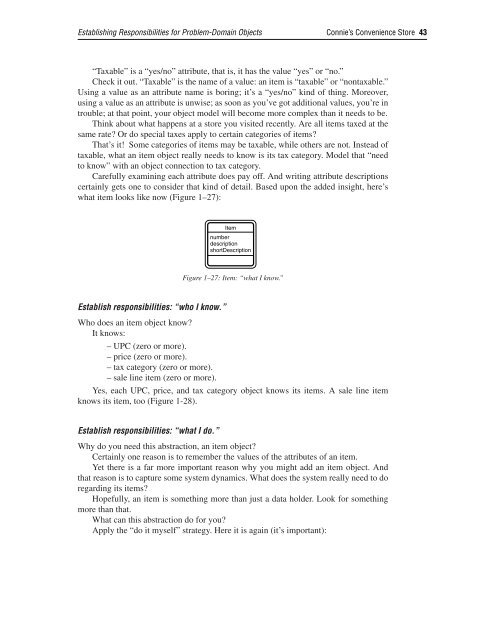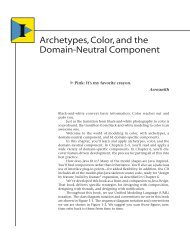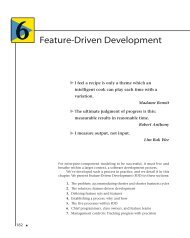Connie's Convenience Store - About Peter Coad
Connie's Convenience Store - About Peter Coad
Connie's Convenience Store - About Peter Coad
Create successful ePaper yourself
Turn your PDF publications into a flip-book with our unique Google optimized e-Paper software.
Establishing Responsibilities for Problem-Domain Objects Connie’s <strong>Convenience</strong> <strong>Store</strong> 43<br />
“Taxable” is a “yes/no” attribute, that is, it has the value “yes” or “no.”<br />
Check it out. “Taxable” is the name of a value: an item is “taxable” or “nontaxable.”<br />
Using a value as an attribute name is boring; it’s a “yes/no” kind of thing. Moreover,<br />
using a value as an attribute is unwise; as soon as you’ve got additional values, you’re in<br />
trouble; at that point, your object model will become more complex than it needs to be.<br />
Think about what happens at a store you visited recently. Are all items taxed at the<br />
same rate? Or do special taxes apply to certain categories of items?<br />
That’s it! Some categories of items may be taxable, while others are not. Instead of<br />
taxable, what an item object really needs to know is its tax category. Model that “need<br />
to know” with an object connection to tax category.<br />
Carefully examining each attribute does pay off. And writing attribute descriptions<br />
certainly gets one to consider that kind of detail. Based upon the added insight, here’s<br />
what item looks like now (Figure 1–27):<br />
Item<br />
number<br />
description<br />
shortDescription<br />
Figure 1–27: Item: “what I know.”<br />
Establish responsibilities: “who I know.”<br />
Who does an item object know?<br />
It knows:<br />
– UPC (zero or more).<br />
– price (zero or more).<br />
– tax category (zero or more).<br />
– sale line item (zero or more).<br />
Yes, each UPC, price, and tax category object knows its items. A sale line item<br />
knows its item, too (Figure 1-28).<br />
Establish responsibilities: “what I do.”<br />
Why do you need this abstraction, an item object?<br />
Certainly one reason is to remember the values of the attributes of an item.<br />
Yet there is a far more important reason why you might add an item object. And<br />
that reason is to capture some system dynamics. What does the system really need to do<br />
regarding its items?<br />
Hopefully, an item is something more than just a data holder. Look for something<br />
more than that.<br />
What can this abstraction do for you?<br />
Apply the “do it myself” strategy. Here it is again (it’s important):




